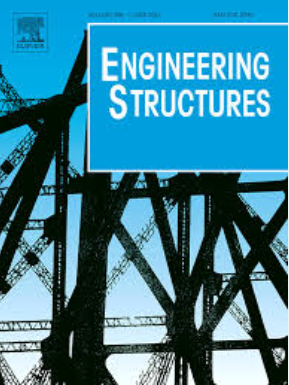一种评估火灾和地震后螺栓连接损伤的实用方法
IF 6.4
1区 工程技术
Q1 ENGINEERING, CIVIL
引用次数: 0
摘要
该研究改进了点音法,为螺栓连接损伤提供了定量评价方法。分析利用快速傅立叶变换(FFT)技术来评估捕捉到轻音频率的音轨。该方法应用于高温下的钢接头和连接中的高强度螺栓,并评估了这些连接的抗震性能。结果表明:螺栓预紧力和扭矩强度越高,轻敲频率越高;然而,由于连接中的较大漂移和暴露在高温下,它可能会显着降低。具体来说,当漂移超过2 %时,频率可能从5 kHz下降到约2.5 kHz。在800℃的火灾损坏情况下,频率可能降至1 kHz以下。这些结果为快速评估大地震和火灾作用下螺栓连接的损伤提供了依据。本文章由计算机程序翻译,如有差异,请以英文原文为准。
A practical approach for assessing damage to bolted steel connections after fires and earthquakes
This study improves the tap-tone method to provide a quantitative evaluation of damage in bolted steel connections. The analysis utilized Fast Fourier Transform (FFT) techniques to assess the soundtracks that captured the tap-tone frequency. This methodology was applied to high-strength bolts within steel joints and connections subjected to elevated temperatures, as well as to evaluate the seismic performance of these connections. The findings indicate that the tap-tone frequency may increase with higher bolt pretension and torque strength; however, it can significantly decrease due to a large drift in the connections and exposure to high temperatures. Specifically, when the drift exceeds 2 %, the frequency may decline from 5 kHz to approximately 2.5 kHz. In cases of fire damage at 800 °C, the frequency may drop below 1 kHz. These results provide a foundation for rapid damage assessment of bolted steel connections subjected to great earthquakes and fire.
求助全文
通过发布文献求助,成功后即可免费获取论文全文。
去求助
来源期刊

Engineering Structures
工程技术-工程:土木
CiteScore
10.20
自引率
14.50%
发文量
1385
审稿时长
67 days
期刊介绍:
Engineering Structures provides a forum for a broad blend of scientific and technical papers to reflect the evolving needs of the structural engineering and structural mechanics communities. Particularly welcome are contributions dealing with applications of structural engineering and mechanics principles in all areas of technology. The journal aspires to a broad and integrated coverage of the effects of dynamic loadings and of the modelling techniques whereby the structural response to these loadings may be computed.
The scope of Engineering Structures encompasses, but is not restricted to, the following areas: infrastructure engineering; earthquake engineering; structure-fluid-soil interaction; wind engineering; fire engineering; blast engineering; structural reliability/stability; life assessment/integrity; structural health monitoring; multi-hazard engineering; structural dynamics; optimization; expert systems; experimental modelling; performance-based design; multiscale analysis; value engineering.
Topics of interest include: tall buildings; innovative structures; environmentally responsive structures; bridges; stadiums; commercial and public buildings; transmission towers; television and telecommunication masts; foldable structures; cooling towers; plates and shells; suspension structures; protective structures; smart structures; nuclear reactors; dams; pressure vessels; pipelines; tunnels.
Engineering Structures also publishes review articles, short communications and discussions, book reviews, and a diary on international events related to any aspect of structural engineering.
 求助内容:
求助内容: 应助结果提醒方式:
应助结果提醒方式:


